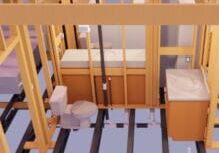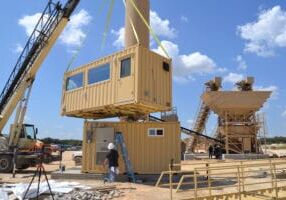Geberit In-Wall Systems Makes a New Breed Luxury Room Concept a Reality for International Hotel Brand
Before heading off on a get-away, many people will watch a YouTube video or buy a book written by travel expert Rick Steves to learn how to get around, what to see, and, many times, where to stay. For his fans to enjoy the adventure, his most often advice is to travel light.
With that kind of guest in mind, the international hotel and lifestyle brand citizenM serves travelers who want to spend their time out and about and not in their rooms. Their hotels also welcome cost-conscious business travelers. With these needs in mind, citizenM’s goal is to make a small room feel spacious and accessible for both able-bodied and for the physically challenged.
Their no-frills approach also means providing simple yet comfortable amenities and effectively addressing property maintenance, limiting downtime, and providing a high level of room cleanliness.
Further, the mission for their properties worldwide is to make the build efficient and eco-friendly.
About Geberit: The globally operating Geberit Group is a European leader in the field of sanitary products. Geberit operates with a strong local presence in most European countries, providing unique added value when it comes to sanitary technology and bathroom ceramics.
The production network encompasses 26 production facilities, of which 4 are located overseas. The Group is headquartered in Rapperswil-Jona, Switzerland. With around 12,000 employees in approximately 50 countries, Geberit generated net sales of CHF 3.4 billion in 2022. The Geberit shares are listed on the SIX Swiss Exchange and have been included in the SMI (Swiss Market Index) since 2012.
Inside Out Art in Form and Function
The first Westcoast citizenM property is in Seattle’s artsy South Lake Union neighborhood and is among the Netherlands-based brand’s initial entries into the United States. The new, modularly constructed building blends in well with the neighborhood and largely mirrors its surrounding buildings in the area with its many art galleries.
The hotel’s exterior features a bright, large-scale commissioned piece that wraps around the two street-facing facades of the building. The piece, by Seattle-based artist Jesse LeDoux, features prominently on the building facade, where every window and its inhabitants are depicted in many colors.
But for the guests, the inside of the hotel counts. To maximize the concept for their hotels designed by long-time architecture partner Concrete Amsterdam, in collaboration with the Seattle office of global architectural firm Gensler, citizenM chose Geberit in-wall toilet tank systems, enabling citizenM to obsess over every inch.
But sparse does not have to be spartan, especially in their bathrooms and lobby (which the brand calls living rooms) lavatories. Geberit in-wall carrier systems contribute to the property’s mission to provide a stylish place to stay for value-oriented travelers, contribute to citizenM’s sustainability mission, and enable access for everyone.
Geberit in-wall flush toilet systems for wall-hung toilets are the classics for modern bathroom design. citizenM has specified the Geberit systems into their bathroom walls worldwide as a basis of their bathroom design. This installation is part of the over one million times building owners have installed Geberit systems in their buildings around the globe for over the past 50 years.
This approach translates into more usable pace in the guestroom. In conjunction with any wall-mounted toilet, the system provides six to nine inches of precious floor space, opening the rest of the space.
Hotel’s Modular Construction and In-Wall Toilet System Save Resources
This citizenM is Seattle's first modular hotel and serves as a model for sustainable hotel design. The building's 264 modules comprise the guestrooms. Below its gridded facade is a steel cage body that provides space for a spacious living room, the 24/7 canteen, four meeting rooms, and all the other amenities guests expect.
Everything above the ground floor was built as units so the hotel is more assembled than built. On average, the Mortenson construction team stacked seven to eight modules at the site. The rooms were set in just 89 days, allowing for a schedule reduction of four months. In addition to shortening the construction timeline, the factory-assembled modules reduce construction costs and waste. They are a higher quality product not subject to risk factors like weather-related delays and labor and material shortages. The contractor determined that 85% of construction debris was recovered, reused, or recycled.
To top off these environmental benefits, the building also boasts solar panels on its roof and a heat pump, a measure rarely used for hotels. The result is a LEED Gold certification and a structure that uses 29% less energy than otherwise.
The Geberit wall mount contributes to the sustainability mission by saving water and has already met high European standards. In addition, every Geberit concealed system comes with a dual-flush capability. Geberit Duofix In-Walls with the Sigma8 concealed tanks pairs the system with the Sigma20 dual-flush actuator plate. The standard volume is 1.6 or 1.28 gallons for solids and 0.8 gallons for liquids, saving each room thousands of gallons of water per year, exceeding high-efficient toilet standards.
In matching the style of the property, Geberit has equipped the sleek finish single flush Sigma10 and Sigma30 flush plates with a stop-and-go flush function that lets the user interrupt the standard flush cycle and can decide precisely how much water they want to use (or save).
Push to flush and push again to stop. Operating is that simple.
In-Wall System Ideal for Cleaning and Maintenance of Hotel
The in-wall toilet design enables their compact stay on top of keeping room bathrooms sanitary. In addition, because the toilet is off the floor, mopping up the bathrooms in their scores of rooms and the lobby, lavatories are much more efficient.
Unlike floor-mounted tank toilets, valves in the in-wall system eliminate problematic chains and flappers that corrode and fail. The maintenance department can easily access working parts through the stylish flush and cover plates if needed. Rather than being housed in a space-consuming tank, the fill and flush valves and supply are behind the wall. All working parts are easily accessed through the flush plate or cover plate if maintenance is required.
To maintain bathroom hygiene, the impact-resistant high-density tank is guaranteed against leaks and insulated to prevent condensation.
“I can say that we have not had any mechanical problems with the flushing system of the bathroom receptacles in either standard or ADA rooms,” according to Christian Logay – citizenM Area Maintenance Manager for the West Coast.
“The water storage tank does not show any signs of leakage or corrosion from any of the parts of the system. Flushing is easy, and having the two different levels of flushing (Eco and standard) does help us save water. Installation of the bowl is easy, and all the water connections are equally simple.”
So far, we have not had any mechanical issues with this system."
Convenience and Accessibility for All
Everyone who checks into citizenM Seattle South Lake Union will find that the facility meets their needs, including those coming through the door in wheelchairs or other mobility assists.
Whether the toilet compartment is intended for ambulatory or wheelchair occupants, the Geberit in-wall tank and carrier system combined with a wall-hung toilet bowl makes the bathroom/lavatory safer and more accessible.
Geberit in-wall system, everyone can live a bit more independently. In addition, eliminating the toilet tank allows greater mobility in the compartment and reduces the injury potential.
To meet ADA requirements, flushing the toilet is more accessible and safer for guests in wheelchairs in both the rooms and the lobby.
The feedback from architects is that one of the challenges is meeting ADA compliance for flush control button location with a wall-hung toilet, so the Geberit Type 10 dual flush remote offset button solutions provide assurance to pass inspection.
“One of the challenges in positioning the flush plates for ADA compliance is when they are positioned beneath the grab bar; the plate has to be a certain thickness,” according to Geberit West Region Sales and Builder Manager, Ronn Jefferson.
So Geberit developed a surface-even panel. We provide a surface even panel for the wall and use the offset button for the reach, which checks every box for ADA compliance.”
The rectangle remote actuators have been tested for years of stress and require less than five pounds of force to actuate the flush. Air pressure transmits the force from the flush control to the flush valve.
The plates offer a sleek, safe, and minimalist appearance. The streamlined design has no protruding edges, enhancing the feeling of spaciousness and safety in these compact bathrooms.
At citizenM, where inches count to provide affordable yet high-end lodging, the Geberit in-wall carrier system enables the hotel to deliver on this mission while making the stay a high point of their guest's visit – no matter who they are.
More from Modular Advantage
AI, Faster Sets, and Automation: The Future of Modular is at World of Modular
While the modular building industry has long known that it can be an effective solution to increase affordable housing, the word is slowly spreading to more mainstream audiences. Three presentations at this year’s World of Modular in Las Vegas hope to provide insight and direction for those seeking a real solution to the crisis.
An Insider’s Guide to the 2025 World of Modular
The Modular Building Institute is bringing its global World of Modular (WOM) event back to Las Vegas, and with it comes some of the industry’s best opportunities for networking, business development, and education. Over the course of the conference’s four days, there will be numerous opportunities for attendees to connect, learn, and leverage event resources to get the most out of the conference.
Affordable Housing Now: The Industry’s Best Bring New Solutions to World of Modular
While the modular building industry has long known that it can be an effective solution to increase affordable housing, the word is slowly spreading to more mainstream audiences. Three presentations at this year’s World of Modular in Las Vegas hope to provide insight and direction for those seeking a real solution to the crisis.
Opportunities for Innovation in Modular Offsite Construction
Modular Offsite Construction has already shattered the myth that it only produces uninspired, box-like designs. Architectural innovations in module geometry, configurations, materials, and products make it possible to create visually stunning buildings without sacrificing functionality or efficiency.
Safe Modular Construction with Aerofilm Air Caster Transport
In collaboration with Aerofilm Systems, Heijmans developed innovative skids using air caster technology for moving modules easily and safely. These pallets are equipped with an auto-flow system, making operation extremely simple.
Miles, Modules, and Memes: Building a Modular Network One Flight at a Time
At the end of the day, social media is just another tool for building connections, and like any other tool, needs to be used skillfully to work properly. Use social media thoughtfully, and it will open doors to real opportunities and relationships you didn’t even see coming.
Falcon Structures: Thinking Inside the Box
Some of Falcon’s latest projects include creating container solutions for New York’s Central Park and an East Coast professional baseball team. More and more, Falcon is shipping out container bathrooms and locker rooms to improve traditionally difficult work environments, like those in oil and gas or construction.
UrbanBloc—From Passion to Industry Leader
UrbanBloc specializes in three main categories or markets – what they call “Phase 0” projects, amenities, and urban infill. Clients are often attracted to shipping containers because from a real estate perspective they are considered an asset. Having the flexibility to move and transport these assets allows owners to respond to different circumstances in a fluid manner that they can’t get with standard construction.
The Hospitality Game-Changer
“Hospitality is about more than just providing a service – it’s about delivering an experience,” says Anthony Halsch, CEO of ROXBOX. “And that’s where containers thrive. They allow us to create spaces that are unique, efficient, and sustainable.”
Container Conversions Counts on Simplicity to Provide Critical Solutions
Container Conversions has fabricated and developed thousands of containers for varied projects, including rental refrigeration options, offices, kitchens, temporary workplace housing, and mobile health clinics.













